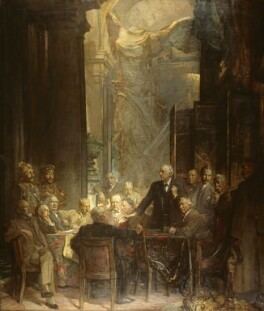 | ||
People also search for | ||
Statesmen of World War I is an oil on canvas painting by Sir James Guthrie, completed in 1930, shortly before Guthrie's death. It was commissioned by South African financier Sir Abraham Bailey, 1st Baronet to commemorate the politicians and statesmen of Britain and its allies who held office during the First World War. It was donated to the National Portrait Gallery in 1930, shortly after it was completed.
Contents
Background
Bailey commissioned two other commemorative portraits, General Officers of World War I (originally entitled Some General Officers of the Great War) by John Singer Sargent, and Naval Officers of World War I by Sir Arthur Stockdale Cope. Bailey paid £5,000 for each of the three paintings and donated all three to the National Portrait Gallery. The third painting, of statesmen, was first offered to Sir William Orpen, but Orpen declined as he had already been commissioned as the official British artist of the Versailles Peace Conference (see, for example, The Signing of Peace in the Hall of Mirrors). Sargent suggested Guthrie instead.
As preparatory work, Guthrie painted a study of each subject separately, considerably delaying the process. He held sittings in the springs and early summers of 1919 to 1921. After a delay caused by Guthrie's illness, the work was first exhibited at the Scottish National Gallery in Edinburgh in early 1930. Guthrie died in September 1930 before he could complete the final finishing touches before it went on display in London in October 1930. His 17 oil studies and an oil sketch of the composition were donated to Scottish National Portrait Gallery. Guthrie's study of Louis Botha was used by Sargent in making his painting of general officers.
Painting
The work measures 156 × 132 inches (400 × 340 cm). It is a group portrait of seventeen figures, some seated and some standing. Unlike the companion paintings by Sargent and Cope, which adopt landscape format to accommodate the many subjects, Guthrie used a portrait format. The subjects are depicted as if in conference around a table in a large hall, in the shadow of a sculpture based on the Winged Victory of Samothrace, with Doric columns to either side and coffered vault above.
The individuals depicted are, from left to right, starting with those seated on the left side of the table:
Standing behind Lloyd George are:
Behind Churchill are:
To their right are:
Bailey decided that the painting should include British and Dominion civilian leaders in office at the beginning and the end of the First World War. It includes Prime Ministers of Australia, Canada, Newfoundland, and New Zealand, and the Prime Ministers, Foreign Secretaries, Secretaries of War, and First Lords of the Admiralty of the United Kingdom, together with two leaders of the British Conservative and Labour parties. The Maharaja of Bikaner, a member of the Imperial War Cabinet and the Indian delegate to the Versailles Peace Conference, stands to the left next to Louis Botha, both in military uniform.
General Kitchener stands in military uniform on the far right, away from the others with his profile in deep shadow. Kitchener died in the sinking of HMS Hampshire in 1916, so this portrait was posthumous.
